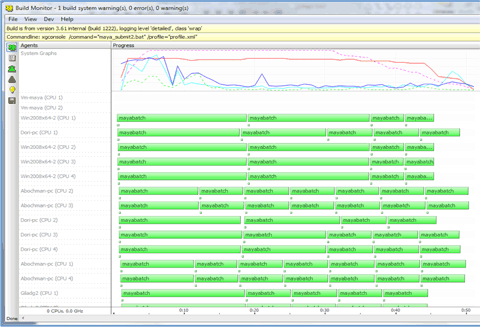
Render job in Maya spread across multiple PCs (agents) across a network
Most computers only use a fraction of their CPU resources, around 10-20% on a typical office PC according to Eyal Maor, CEO of grid computing specialist, Xoreax.
With an office-full of multi-core PCs this can soon add up – you may even find yourself with a virtual supercomputer you never knew you had. Think of what that could do to your backlog of rendering and simulation jobs?
This is the idea behind IncrediBuild-XGE, a new Windows-based distributed computing solution from Xoreax designed to tap into processing resources that lie idle in many firms. The technology is designed to transform a network of office PCs, workstations and servers into a private cloud in which every node – from user workstations to dedicated servers – can contribute unutilised processing power to form a virtual supercomputer.
The bold claim from Xoreax is that its software ‘eliminates the need for expensive dedicated clusters’ and ‘radically lowers ongoing maintenance costs’. IncrediBuild-XGE also allows processing to scale out to public clouds.
Maor claims implementation is rapid and told DEVELOP3D that Xoreax already has customers who have tailored IncrediBuild-XGE to accelerate rendering in 3ds Max, Maya and SolidWorks.
However, the Israeli firm is primarily looking to work directly with software developers – including those in finance, data conversion and gaming as well as CAD/CAM/CAE and rendering – to integrate its distributed computing technology or to offer IncrediBuild-XGE as an OEM solution.
The software can work with shared memory and distributed memory solvers and renderers. It is also not limited to CPUs with Xoreax looking to CUDA and OpenCL to harness the power of Graphics Processing Units (GPUs).
Maor explains that Xoreax is currently talking to ‘all the major CAD software companies’, though it is still early days as IncrediBuild-XGE has only just been released. He is keen to emphasise that Xoreax is not a new company though; it has over 10 years of experience in distributed computing and its XGE technology is already used by over 2,000 firms including 20 of the Fortune 100.
One firm that is already benefiting from XGE is Sarin Technologies, whose software is used to analyse rough diamonds and determine the optimal cutting parameters. Sarin’s optimizer software runs through dozens of shapes (3D meshes with predefined parameter ranges such as angles and heights) to identify the most valuable combination of shapes for the given rough stone. According to Xoreax, by using XGE Sarin has been able to reduce processing time from 40 hours to less than two.
XGE technology certainly sounds like an interesting proposition. PCs don’t exactly break into a sweat running spell check in Word. Even in a design/engineering environment there are times when CAD workstations are significantly underutilised.
But there are also likely to be significant challenges. While IncrediBuild-XGE automatically manages the workload it puts on individual machines (agents) finding the right balance may be hard in workstation-heavy environments where CPU usage can vary dramatically. Also, with computer-aided-engineering (CAE) solvers, where large amounts of data often needs to move between nodes, bandwidth could be an issue and also impact general network performance. Indeed, this is the main reason that Infiniband is used in dedicated CAE clusters.
In the last year we’ve seen a number of technologies that are designed to offload and accelerate compute intensive CAD/CAM/CAE and rendering tasks. Autodesk 360 rendering offers designers a direct connection to the cloud while Nvidia Maximus uses the GPU to free up workstation resources. Making full use of the untapped processing power that already exists within a firm makes a lot of sense, but to have a significant impact in the design and engineering sector it will need the backing of the CAD/CAM/CAE software developers.






